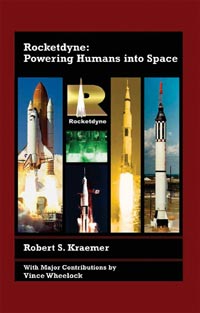Review: Rocketdyne: Powering Humans Into Spaceby Anthony Young
|
| Rocketdyne’s history was a story that remained curiously untold until the publication of this book. |
That said, the authors chose the subtitle to convey the emphasis on Rocketdyne’s engines used in human spaceflight. The book covers the engines used for the Mercury/Atlas flights as well as chapters devoted to the H-1 used on the Saturn 1 and 1B, and the F-1 and J-2 used on the Saturn 5. There is a final chapter devoted to the Space Shuttle Main Engine (SSME). The SSME is the longest-running Rocketdyne engine program, spanning more than a quarter of a century. Some idea of the complexity of the SSME and its design, development, and manufacturing program was evident when Rocketdyne submitted 100 volumes as part of its proposal to NASA during the competitive bid process. Kraemer does a credible job condensing this huge program down to a chapter, but the full story of the SSME will have to wait for a future historian, perhaps after the shuttle is finally retired.
Kraemer includes an epilogue to briefly cover the RS-68 that powers the Delta 4 variants. A cluster of five RS-68 engines will provide the liquid propellant thrust for the Ares 5, aided by two SRMs. He also mentions the unfulfilled promise of the linear aerospike engine.
At only 274 pages, including appendices and index, this is a surprisingly slim volume, considering the rich history of Rocketdyne. Nevertheless, Kraemer and Wheelock devote sufficient space to each engine without delving too deeply into the technical. The authors also emphasize the human side to Rocketdyne—the engineers and managers who made these rocket engines a reality. Kraemer interviewed a fair number of them for this book but, sadly, many key people had passed away before this book was started.
The book is well-illustrated but most photos display an odd digitization that resulted in some loss of resolution. Fortunately, many of the key individuals who worked at Rocketdyne over the last fifty years are illustrated here as well. Rocketdyne has been owned by several aerospace conglomerates over the years. Today it is a division of Pratt & Whitney. Fortunately, the name remains as part of the corporate structure as Pratt & Whitney Rocketdyne. Rocketdyne: Powering Humans Into Space fills a longstanding void on the history of this venerable company and its engines that put American astronauts into space.
